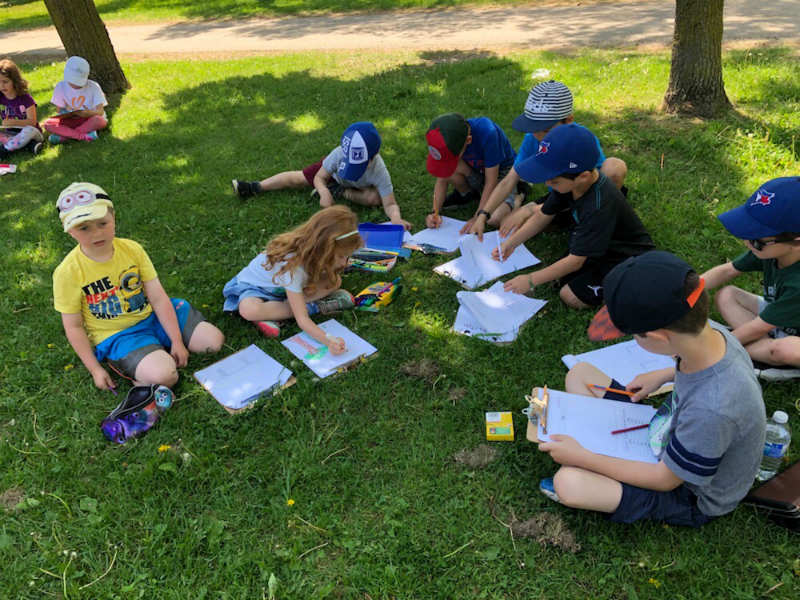Just over six years ago, the south campus of The Leo Baeck Day School in Toronto closed its doors for the summer, with 360 students enrolled. When it reopened a few months later, that number was up to 455.
In the interim, Leo Baeck had moved its south campus from its building on the Holy Blossom Temple’s property, to a new building on Arlington Avenue, near Cedarvale Park.
So how does the new location compare to the old one?
“I would say you can’t compare. It has dramatically changed the entire experience of our student body,” said Eric Petersiel, Leo Baeck’s head of school.
“It is moving from an enclosed concrete space – where we tried everything we could at the other site to be creative, to try to give kids some outdoor space – into the edge of a ravine.… It’s not just about play, it’s about how the entire educational experience is tied to the outdoors in a way that we couldn’t on our previous site.”
In other words, Leo Baeck has gone from parking lot, to paradise.
At Holy Blossom, the closest thing Leo Baeck had to green space was a patch of Astroturf in the lot next door. At its new location, the school added an outdoor sports area and a playground, and has access to a children’s garden and softball and tennis courts that are owned by the city.
Even six years after the move, Petersiel is still passionate about the difference he sees at his school.
“Everybody just feels so much happier and less restrained. The opportunity for a teacher to, as I say, take the kids to the hockey rink next door, take the kids to the children’s garden, take the kids to the ravine for an educational lesson, their doors are open,” he said.
It’s never been a secret that children need sufficient physical activity to thrive, but now there is ample evidence to back up that belief, and research outlining how and why physical activity is so crucial.
“If children lack physical literacy, if they don’t have the opportunity to develop those fundamental movement skills and competence and confidence, then they’re likely to be physically inactive as they get older,” said John Cairney, a professor in the faculty of kinesiology and physical education at the University of Toronto and a professor in the department of family medicine at McMaster University.
“We know now (there is) very very strong evidence around the relationship between physical inactivity and physical and mental health problems.”
According to Physical and Health Education Canada, physical literacy is “the motivation, confidence, physical competence, knowledge and understanding to value and take responsibility for engagement in physical activities.”
Cairney says children develop physical literacy by engaging in different types of activities, in different types of environments, so it’s important to present them with different options for play.
That being said, Cairney is aware that not every school has access to the ideal play space (for Cairney, that’s “a nice playground, maybe in a forest setting”). But that doesn’t mean those schools should just resign themselves to not being able to provide adequate options for their students.
So if a school isn’t located at the edge of a lush green space, “I don’t want to make it seem like there’s no hope. I think there is hope,” said Cairney. “You have to be creative with spaces. But the intention and the will has to be there.”
Schools understand this now and those that aren’t able to upgrade campuses as spectacularly as Leo Baeck are using new and creative methods to provide their students with as diverse a physical education as possible.
READ: SERIOUSLY ILL KIDS JOIN IN BACK-TO-SCHOOL RUSH
Back when Toronto’s Robbins Hebrew Academy (RHA) was still the United Synagogue Day School, the students would have access to a gym a few times a week and recess in a parking lot. That would often be the extent of their physical activity. Now, under head of school Claire Sumerlus, there is a much more concentrated effort to provide students with diverse options for physical activity.
“Our kids … need more opportunities to move around,” she said. “It’s not all being out on the playground.”
So RHA is looking at different types of moving desks and chairs, to allow students to expend energy and be active when they’re sitting in class.
The school has also designated a green space at the side of the property for kids to play in, instituted a program that mandates 20 minutes of daily physical activity every morning and often sends its students to learn at Cedarvale Park. Sumerlus said they also plan to build a rooftop playground, hopefully within the next five years.
Associated Hebrew Schools (AHS) doesn’t have five years to build a new playground. This school year, it is consolidating two of its campuses, moving the elementary school children from their northern campus on Atkinson Avenue in Thornhill, to its campus on Finch Avenue in Toronto, which currently houses its middle school.
Ora Shulman, the director of education for AHS, realizes the value of physical activity.
“We also have seen the effect on students’ behaviour and concentration, we’ve seen a positive effect on self-concept and academic performance,” she said. “So our students spend at least an hour a day outside.”
For that reason, AHS is building a new playground at its Finch campus and plans to use the adjacent Ancona Park as a source of green space, as well.
Not every school can have immediate access to the same kind of resources as Leo Baeck, but schools are aware of how children need for physical activity and are working hard to meet those needs.
